
The Crassulaceae, also known as the stonecrop family or the orpine family, are a diverse family of dicotyledon flowering plants characterized by succulent leaves and a unique form of photosynthesis, known as Crassulacean acid metabolism (CAM). Flowers generally have five floral parts. Crassulaceae are usually herbaceous but there are some subshrubs, and relatively few treelike or aquatic plants. Crassulaceae are a medium-sized monophyletic family in the core eudicots, among the order Saxifragales, whose diversity has made infrafamilial classification very difficult. The family includes approximately 1,400 species and 34–35 genera, depending on the circumscription of the genus Sedum, and distributed over three subfamilies. Members of the Crassulaceae are found worldwide, but mostly in the Northern Hemisphere and southern Africa, typically in dry and/or cold areas where water may be scarce, although a few are aquatic.
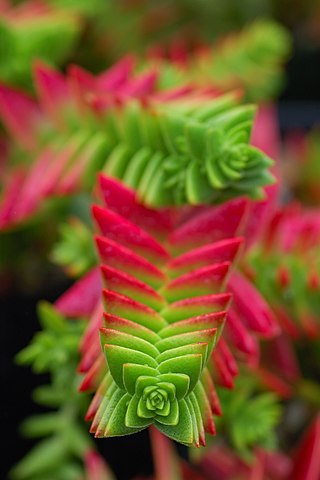
Crassula is a genus of succulent plants containing about 200 accepted species, including the popular jade plant. They are members of the stonecrop family (Crassulaceae) and are native to many parts of the globe, but cultivated varieties originate almost exclusively from species from the Eastern Cape of South Africa.

Crassula connata is a succulent plant in the family Crassulaceae. It is known by the common names sand pygmyweed and pygmy stonecrop. It is a very small plant which grows in patches on the ground, especially in rocky areas. It is also sometimes associated with vernal pool plant communities. The stems are a few centimeters in length and are covered with tiny fleshy pointed leaves. Each leaf is only millimeters long. The plant is green when new and it matures to shades of pink and red. It is found in western North America and in parts of Central and South America.

Crassula helmsii, known as swamp stonecrop or New Zealand pigmyweed, is an aquatic or semiterrestrial species of succulent plant in the family Crassulaceae. Originally found in Australia and New Zealand, it has been introduced around the world. In the United Kingdom, this plant is one of five introduced invasive aquatic plants that were banned from sale from April 2014, the first ban of its kind in the country. It is on the Global Biodiversity Information Facility's Global Register of Introduced and Invasive Species of eleven countries.

Crassula aquatica is a succulent plant known by the common names water pygmyweed, common pygmyweed and just pigmyweed. It is an annual plant of salt marshes, vernal pools, wetlands, and other fresh to brackish water bodies. It is at least partially aquatic, living in areas which are submersed much of the time. It also lives along muddy banks and in tidally-active areas of estuaries.

Crassula tillaea is a succulent plant known by its common names mossy stonecrop and moss pygmyweed. It is a small fleshy plant growing only a few centimeters in height. It is green when new and gradually turns orange and then deep red when mature. It has tiny triangular pointed leaves only a few millimeters long. A tiny flower or pair of flowers grows between each oppositely-arranged pair of leaves; the flowers are about two millimeters in length and width. The fruit is a minute follicle containing one or two seeds. This plant is native to Eurasia, particularly the Mediterranean Basin, but is known in other regions as an introduced species.

Crassula tetragona is a succulent plant native to Southern Africa. It is widely distributed from the Orange River boundary of Namaqualand to beyond the Kei River in the Eastern Cape. "Tetragona" comes from the phyllotaxy of the leaves. It is popularly named the "miniature pine tree" among ornamental plant enthusiasts, for its popular use as a "pine tree" in Bonsai.

Crassula arborescens—the silver jade plant, silver dollar (jade) plant, beestebul, Chinese jade, cookie plant, money plant, or money tree, is a species of succulent plant in the family Crassulaceae. It is endemic to Western Cape, South Africa, and grows into a 2 to 4 ft, succulent shrub. Unlike the related Crassula ovata, C. arborescens has rounded, red-edged, gray leaves shaped like "silver dollars" or "cookies". It blooms in summer, with typical star-shaped Crassula white or pink flowers. It is cultivated as an ornamental plant for use in drought tolerant and succulent gardens, and in container gardens. It is also suitable for growing indoors as a houseplant if provided with full-exposure, sunny windows or grow lights, to prevent etiolation.
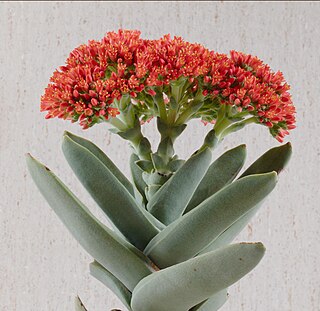
Crassula perfoliata var. falcata, known by the common names airplane plant and propeller plant, is a succulent plant endemic to South Africa, from the Cape of Good Hope. The foliage is gray-green with striking texture, on plants that grow to 2 feet (0.61 m) tall. The flowers are tiny and scarlet red, that rise in dense clusters above the foliage for a month in summer. Crassula falcata is cultivated for use in drought tolerant and succulent gardens, and in container gardens.

Paeonia daurica is a perennial herbaceous plant belonging to the peony family. It has slender carrot-shaped roots, leaves mostly consisting of nine leaflets, with one flower per stem. The flower is subtended by none to two leafy bracts, and has two or three sepals, five to eight petals, and many stamens. The subspecies vary in the colour of the petals, the size and shape of the leaflets, and the hairiness of the leaflets and the carpels. Paeonia daurica can be found from the Balkans to Iran, and the Crimea to Lebanon, with the centre of its distribution in the Caucasus. It is also cultivated as an ornamental.

Corallina is a genus of red seaweeds with hard, abrasive calcareous skeletons in the family Corallinaceae. They are stiff, branched plant-like protists with articulations. Corallina, like all red algae, are not considered plants, despite being photosynthetic.
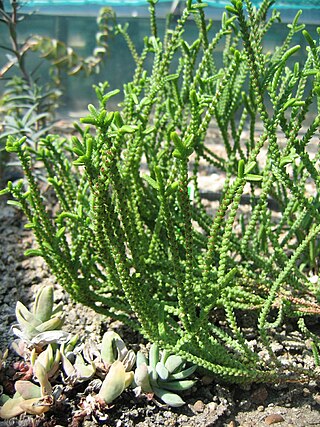
Crassula muscosa, synonyms Crassula lycopodioides and Crassula pseudolycopodioides, is a succulent plant native to South Africa and Namibia, belonging to the family of Crassulaceae and to the genus Crassula. It is a houseplant grown worldwide and commonly known as rattail crassula, watch chain, lizard's tail, zipper plant and princess pines.

Crassula capitella, is a perennial succulent plant native to southern Africa.

Crassula ovata, commonly known as jade plant, lucky plant, money plant or money tree, is a succulent plant with small pink or white flowers that is native to the KwaZulu-Natal and Eastern Cape provinces of South Africa, and Mozambique; it is common as a houseplant worldwide. Much of its popularity stems from the low levels of care needed; the jade plant requires little water and can survive in most indoor conditions. It is sometimes referred to as the money tree; however, Pachira aquatica also has this nickname.
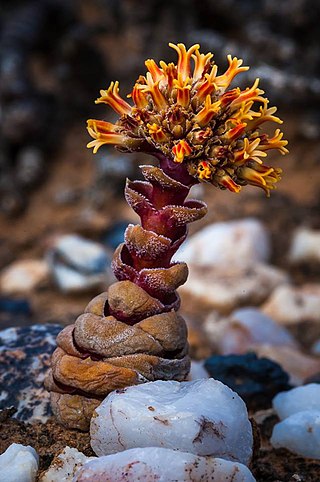
Crassula columnaris is a succulent plant native to South Africa and Namibia.

Crassula rubricaulis is a succulent plant native to the coastal mountains of the Eastern Cape and Western Cape of South Africa.

Crassula ericoides is a species of succulent plant in the genus Crassula native to South Africa. Growing in the fynbos ecosystem of South Africa, C. ericoides somewhat resembles a heather, growing into an upright shrub with bare lower stems and yellow flowers at the tips.
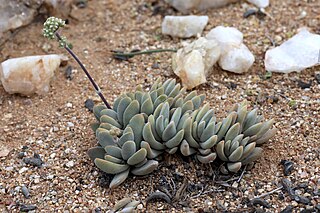
Crassula namaquensis is a species of succulent plant in the genus Crassula native to South Africa. Easily confused with some forms of Crassula tecta and Crassula sericea, this species has rounded to elongated leaves that are usually blue, covered in fine hairs, and form clumps.
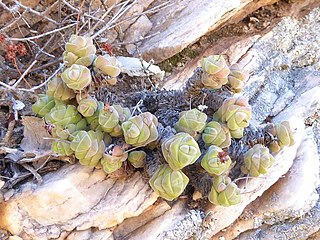
Crassula columella is a species of succulent plant in the genus Crassula from the west coast of South Africa and Namibia. It grows slowly in spring and autumn, and is dormant in summer.



















